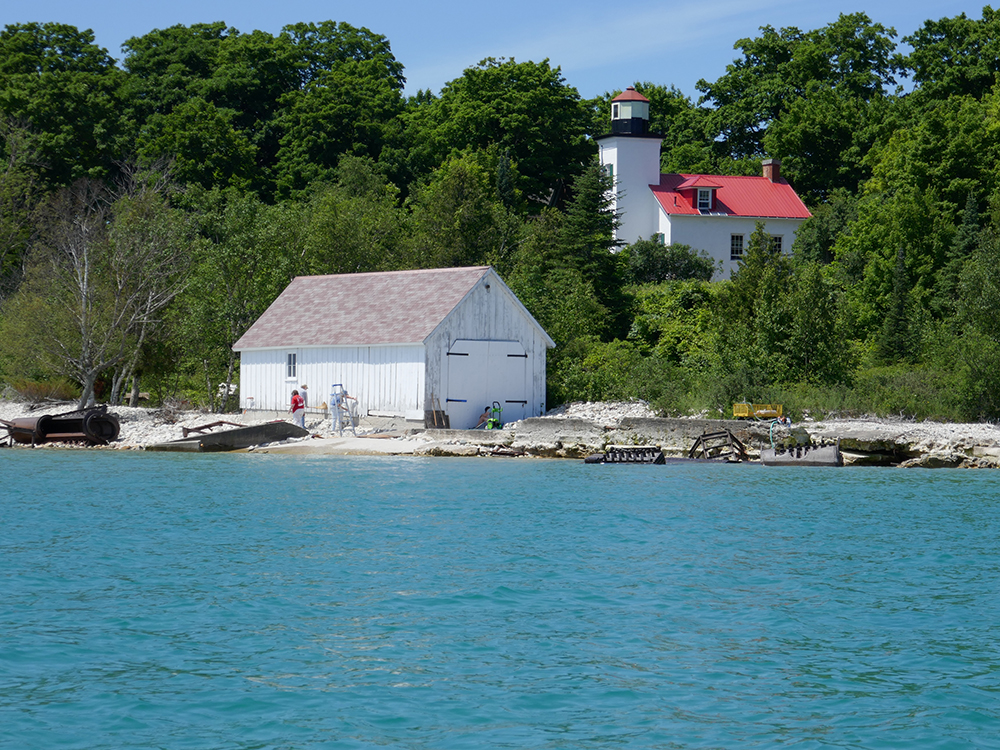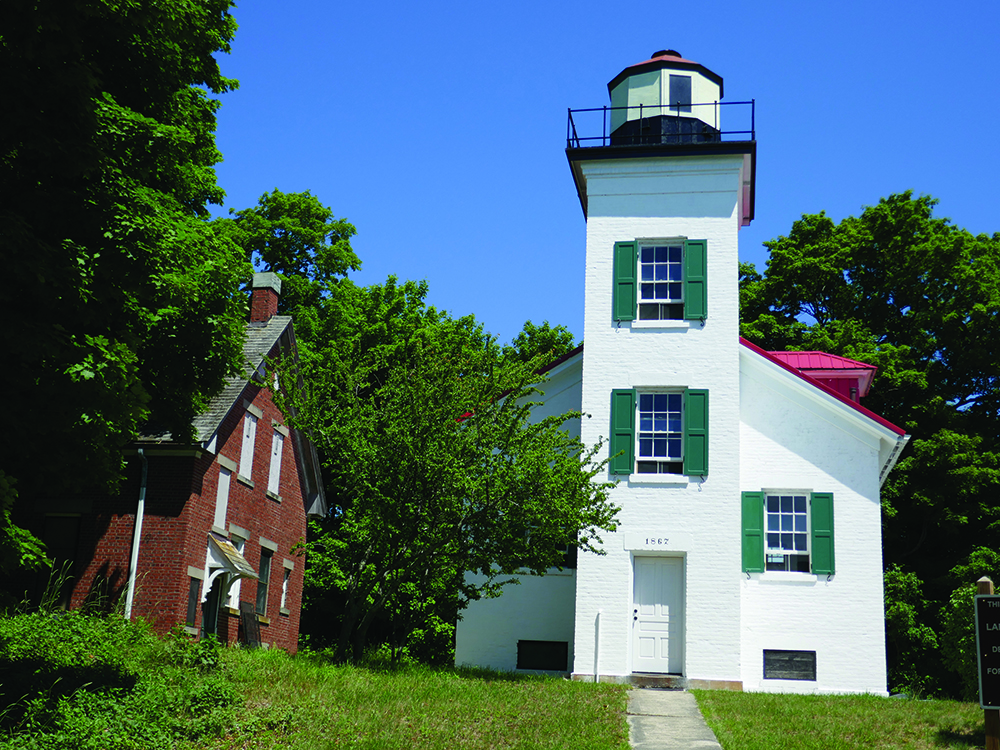How volunteers make it happen
By Sandra Serra Bradshaw
Current Contributor
The South Fox Island Light Station is located 17 miles off the tip of the Leelanau Peninsula in northeastern Lake Michigan and is technically a part of Leelanau County. The “crown jewel” of this historic complex is the light tower, built in 1867. It rises some 39 feet above its base and 69 feet above the lake level. It sat—for the most part—alone and forlorn since it was deactivated by the United States Coast Guard (USCG) in 1959.
The light’s main component was its Fourth Order Fresnel lens, installed in the highest point of the structure. It was manufactured by L. Sauttier & Co. of Paris, and it was first lit in November 1867 to protect passing sailors in these sometimes tumultuous waters.
This summer, the lighthouse reached a milestone of sorts—no longer peeling and in disarray, this historic structure has been whitewashed to near perfection, now standing tall, gleaming, and bright.
The work was done by Munising-based couple Carl and Dori Behrend of Old Country Painting & Restoration—the duo has a long history of whitewashing and painting lighthouses, including work at Au Sable Point, Middle Island, Ile Aux Galets, Seul Choix Pointe, and St. Helena Lights. Carl specializes in hard-to-reach lights, where traditional scaffolding is not practical; when the job requires it, he paints suspended from a bosun’s chair. In the South Fox painting project, he was assisted by tuckpointing expert Mark Lee of Hessel, Michigan. Lee tuckpointed the building in preparation for the Behrends’ whitewashing.
The 1867 light was joined in 1934 by a second light, a steel skeletal tower, and the older light then was used as an emergency back-up system, making way for the new and more powerful beacon. The newer light is a steel skeletal tower, 60 feet high above its base, and it still stands, located not too far from the brick 1867 lighthouse.
In 1933, the tower was transferred from Sapelo Island, Georgia. In the late 1950s, the last USCG crew abandoned the island after the light on the skeletal tower had been automated; the station was fully decommissioned in 1968. It—along with many other lights of the era—was no longer needed as modern-day navigational technology began to take over their once unique, privileged duty. The Michigan Department of Natural Resources (DNR) is now in charge of the state-owned property; this includes 112 acres of the lighthouse property.
Being situated so far offshore makes preserving the light structures and adjacent buildings a formidable task. The whims of the winds and the weather sometimes complicate safe passage from the mainland to the island.
In October 2004, persons of the then-newly-formed Fox Island Lighthouse Association (FILA) met with DNR staff, the Grand Traverse Lighthouse, and other interested people.
“We had no boat, nor any money, yet we all agreed: the right persons would come along at the right time,” says John McKinney, FILA president and one of the organization’s founders.
That motto has rung true time and time again with many that have donated their time, funds, efforts, and good will towards this ever-ongoing project. Despite all of the obstacles, most notably the far offshore location, one by one the hurdles have been overcome. The cumulative result of many years of volunteers’ hard work is in finally seeing the 1867 light whitewashed and proudly gleaming.
“We have been blessed with volunteers through each of these many summers,” McKinney says. “Without their enthusiasm, dedication, various skills and hard work, FILA would never have achieved so much.”
The DNR itself, admitting the immense hardship of caring for the island and its structures, noted:
“This Station is one of the public natural, cultural, and historic resources managed by the Parks Division that does not receive any direct supporting revenue from user or access fees. State budget difficulties have resulted in no publicly funded repair or maintenance for many years. The South Fox Island Light Station is a unique public property…”
Finally, in 2013, the DNR—noting the long-standing serious commitment and dedication of its ever-growing cadre of volunteers—granted FILA a 25-year lease.
Prior to the lease agreement, however, FILA workers had quite a few accomplishments: these included saving the boathouse, which. Mother Nature had nearly destroyed. Powerful waves had thrown ashore tons of rocks, many of which had landed in the boathouse’s very interior. The structure leaned so badly that it looked as if it would simply fall over in the next big wind.

But the rocks were moved, many by the might of one of FILA’s first members, Northport sailor Phil von Voigtlander, who had recently retired from his duties as a pharmaceutical research director. He is also vice chair of the Grand Traverse Bay Watershed Center. He did the heavy stone-hauling after his retirement; no young spring chicken, he took it all in stride. Later, more stone removal was done with the support of machine power, manned by a team headed by Jerry Spears, also of Northport. The boathouse’s once heavily lopsided structure was corrected, given new “life-support,” repaired, and re-roofed—saved in the nick of time, yet more was to come in the future.
As it happens, Mother Nature had her own ideas.
The rising lake levels of 2018 through 2020 pounded the shore of this small island, amply re-piling the many rocks back on shore, again blocking entrance to the boathouse’s new front doors. Volunteers were back to square one again this summer.
“Although, as a Great Lakes sailor, I first visited South Fox Island in the 1970s and periodically for several decades thereafter, it was in 2001 that everything changed,” explains von Voigtlander. “Going ashore at the light station, I was struck by the deterioration of the buildings and overgrowth covering the sidewalks and impinging on the buildings. I was thinking someone ought to do something to save this historic treasure. Later that summer, I visited St. Helena Island [in Mackinac County] and was surprised to see the progress made on the protection and restoration of this lighthouse. Clearly being isolated on an island did not excuse allowing the deterioration of these beacons of the Great Lakes.”
He continues:
“A few years later, I became aware of the nascent Fox Island Lighthouse Association [FILA], which at that time aspired to take on the challenge at South Fox but lacked boats and the local knowledge to use them to access the station. But they were in the process of considering the gift of a retired charter fishing boat and contacted me to evaluate it.”
That donated boat, now named Lightkeeper, was bought a few years later from the association in 2012 by FILA co-founders and board members H. Joerg Rothenberger and myself. The boat, captained by Rothenberger, faithfully takes volunteers out to the island every summer, and sometimes other boats contribute to the transportation efforts.
Thus far—since the first trip in 2006 on the volunteer vessel Showboat of Northport—there have been more than 120 work trips to the island, totaling about 7,300 nautical miles, which roughly equals the distance from Leelanau County to Bangkok, Thailand. The number of volunteers is ever-growing, as the mission continues to save this historic Great Lakes light station.
“I have been following the progress of FILA in the restoration of the South Fox Island Light Station since its inception,” says local author Kathleen Craker Firestone of Northport. Her family logged the island back in the mid-1950s through the early ’60s. “The volunteers are doing a fantastic job. It does my heart good to see the care and restoration that has taken place since I was an explorer of the once forlorn and abandoned complex.”
One project, started in 2014 and still ongoing, is also one of the most exciting.
For the first time since 1959, light again shines inside the darkened interior of the 1867 lighthouse. The wood covering the windows had been removed, and the old—some cracked, but all delicate—window sashes were carefully removed and wrapped for safe voyage aboard the Lightkeeper back to the mainland. There, they were lovingly restored, returned to the island, and re-hung.
Meanwhile, more windows from other buildings have undergone similar treatment. A vast majority of this work is being done by FILA members John and Karen Wells of Muskegon. In the removal and transport process, only one window pane has been broken thus far in the efforts across the lake.
“Restoring the windows was huge,” Karen says. “It brought light and air and hope to the project. Since then, more than 50 people from more than four states and three counties have contributed to the effort. It’s a dream come true for all of us who have believed and helped make it happen.”
“The rest is, as they say, history but involved countless friends and volunteers that I had the pleasure to introduce to this special place,” von Voigtlaner says. “The amazing stabilization, protection, and restoration of the buildings and grounds is a testimony to their strength, courage, and skills. Along the way, there were too many harrowing tales to recount, but we can treasure the memories of them for the rest of our lives.”
Visit SouthFox.org for more information about the South Fox Island Lighthouse Association. Sandra Serra Bradshaw is FILA co-founder and board member.
A version of this article first published in the Glen Arbor Sun, a Leelanau County-based semi-sister publication to The Betsie Current.
Featured Photo Caption: Renovating a lighthouse takes a lot of work. Photo courtesy of H. George Rothenberger.





A huge thank you to all the dedicated volunteers, and folks who have made donations to save this treasure.